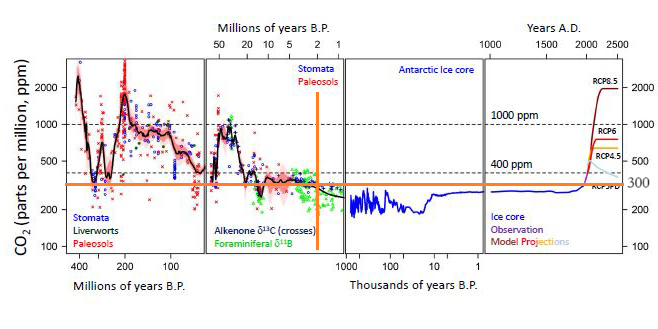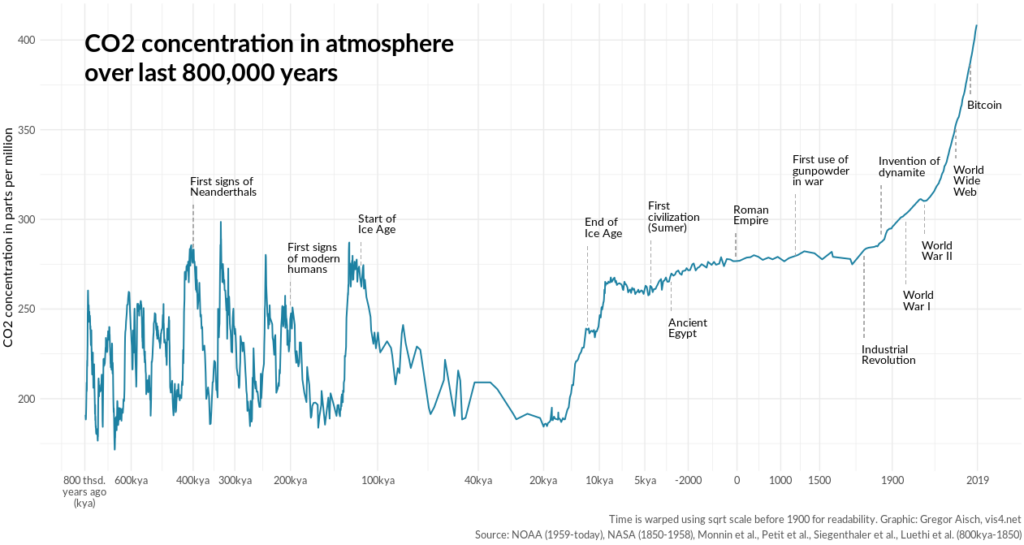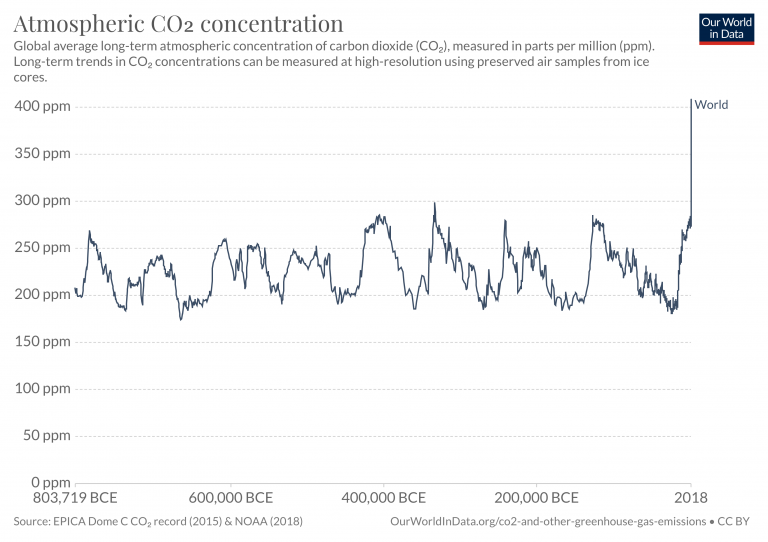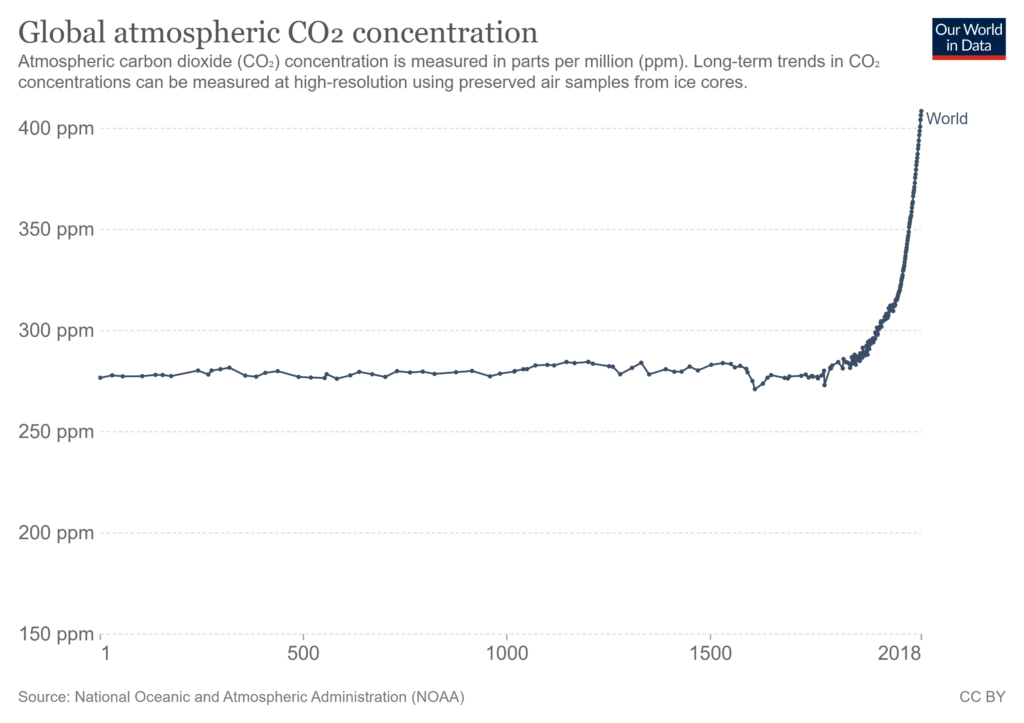For All Human Existence, CO2 Levels Never Exceeded 300 ppm
CO2 levels have increased dramatically since the start of the industrial revolution, 280 ppm. Today we are over 400 ppm. Climate change is one effect of this increased level. Plant nutrition depletion is another effect and has also been measured. Fortunately, there are efforts to understand the nutrition depletion mechanisms, increased CO2 levels being the culprit. Modern humans have thrived when CO2 levels were below 300 PPM, averaging between 200 – 250 ppm.
Records of plant nutrition, minerals and vitamin levels go back to 1950, by USDA. Since then, our plants and animal nutrition levels have depleted. Apples have lost 80% of vitamin content since 1950. Kale lost 27% of iron. Bananas lost 76% of copper. Carrots lost 99% of vitamin A. Beef has lost 54% of iron, 24% of copper, and 41% of calcium. Humans and animals depend on nutritious plants. A generation of people in the 1950’s were three times less likely to be overweight than our generation and had less health problems than we do.
CO2, a greenhouse gas, in our atmosphere has a unique history. As far as humans are concerned, it has been stable for over 200,000 years, when humanity started. In the industrial era we have we seen abnormal increases. So, modern human’s entire existence has relied on a CO2 concentration of less than 300 ppm. Our climate is changing, and we contribute this change to increased CO2 levels and other greenhouse gasses. But there is another change occurring, and that is a nutrition depletion in our plants and animal foods. Researcher, Irakli Loladze, contribute this nutrition depletion, due to increased CO2 levels. It makes since, because plants absorb CO2, sunlight and exhale oxygen. So, if the CO2 level changes then the plant’s ability to process the CO2 might impede on its ability to absorb nutrition from the soil.
There is an article published in Politico Magazine on 9/13/2017 that explains this. You must read this article first before you read on. Don’t worry, It’s in plain English. So, you will be able to understand it. The great nutrient collapse (politico.com)
Another article you should read is this. A Graphical History of Atmospheric CO2 Levels Over Time | Earth.Org – Past | Present | Future.
Here are a few observations, I would like to make.
This chart was copied from earth.org, A Graphical History of Atmospheric CO2 Levels Over Time | Earth.Org – Past | Present | Future without permission. I hope they don’t mind.

BP: Before the Present AD: Anno Domino, Latin for “In the year of the lord”. Notice, the charts date starts at 400 million years B.P. and the end date is 2500 A.D.
Charts can be deceiving, look at the chart above, carefully. The x axis is logarithmic and can be a bit confusing. If the plot distance between data points is maintained, then time plot of data spanning millions of years would not be plottable, it would go past the side of the page. So, time data is processed Logarithmically and used in charts to compress the data to fit on the page or chart.
Also, note, the CO2 levels 400 million years ago were at 3000 ppm. Moving to the right, in the third box, the levels are 200 – 275 ppm. 3 million years ago, the levels fell below 300 ppm. Modern humans have only been around for 1 million years. Thriving and reproducing when the CO2 levels were less than 300 ppm.
The next chart below shows the CO2 levels in the past 800,000 years. Note, for the past 800,000 years the levels of CO2 never went above 300 ppm. This is the first time for all of human’s existence, that the CO2 levels are higher than 300 ppm. Once the Industrial Revolution started the CO2 levels have rose over 300 ppm. We are over 420 ppm.

This plot shows that we evolved and have lived on earth when the levels were below 300 ppm. This is what our bodies are designed for. Note: Plants have been around and evolving for 400 million years.
We are now over 400 ppm. This is humanities first time, above 300 ppm. The plants that we evolved with for the past 800,000 years has not seen levels above 300 ppm. I believe this is causing nutrition depletion in our vegetables and animals. Yes! animals too, since they eat vegetables, which are depleted of nutrition.
The next two plots are from website ourworldindata.org/atmospheric-concentrations Atmospheric concentrations – Our World in Data. Copied without permission, of course. I hope they don’t mind.

Please note, that for 800,000 years the CO2 levels oscillated but never went over 300 ppm. Until the Industrial Age began. The CO2 levels seem to average around 225.
The next chart is the famous hockey stick chart. Showing the start of CO2 levels climbing in the Industrial Age.

Other gas compounds:
1. CO2 carbon dioxide
2. CH4 Methane. The Challenge | UNECE
3. N2O Nitrous oxide, 75% of gas is from agriculture. What Is Nitrous Oxide and Why Is It a Climate Threat? – Inside Climate News
4. Fluorinated gases, man-made, Emitted from a variety of manufacturing and industrial processes. Greenhouse Effect 101 | NRDC
5. H2 Hydrogen, Yes H2 is a secondary greenhouse gas. 39na1 (europa.eu)
It could be that the nutrition depletion of our foods, plants and animals, is due to increased levels of CO2 in our atmosphere. The research for this has not been scientifically corroborated yet. But if it is true, we are nutritionally deficient and we don’t even know it. Maybe this is why we are less healthy than the citizens were in the 1950’s.
Please help try to start the studies and experiments, to determine if CO2 levels above 280ppm, are a cause of plant nutrition depletion. Thanks for helping and good luck.
Update 6/19/2022:
Found article that reports nutrition loss due to CO2 and supplement efficacy
Supplements:
1. Dietary supplements: Do they help or hurt? – Harvard Health
There are a lot of encouraging news supporting supplement efficacy. It turns out most of the reports come from observation. Real research proves otherwise. Dr Manson from Harvard health recommends getting your vitamins and nutrients from food, not supplements. This article is worth a read.
2. Most Vitamin Pills Are Useless, But Here Are The Ones You Should Take (sciencealert.com)
This article gives advice on supplements to take and avoid.
3. The Truth About Supplements: 5 Things You Should Know (pennmedicine.org)
Sometimes supplements don’t work, sometimes they do. A healthy food diet is advised.
Vanishing nutrients:
1. Vanishing Nutrients – Scientific American Blog Network
Update: 1/29/2023
Found article that reports nutrition loss due to CO2
- https://news.climate.columbia.edu/2022/01/27/how-climate-change-will-affect-plants/